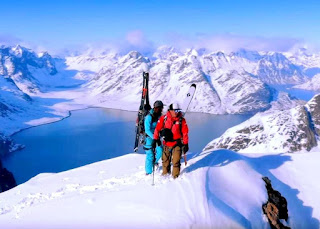Thursday, November 29, 2018
DroneSAR & the Irish Coast Guard
Learn about how the Irish Coast Guard use drones to reduce risk and save lives
Do you have a story of drones coming to the rescue or assisting your agency? Please share in the comments.
Friday, November 9, 2018
Expedition Greenland: Jimmy Chin Takes the DJI Mavic Zoom for a Spin
Drone Below November 5, 2018
The professional mountain photographer and filmmaker who
is known for working at some of the most remote places on earth, Jimmy Chin,
has been recently involved in a new film. This time, Chin collaborates with DJI
to explore its flagship drone, the DJI Mavic Zoom, taking it to an expedition
which follows the climber Alex Honnold as he became the first person to ever
solo climb the 3,000ft El Capitan Wall at the Yosemite mountains.
In his 20-year career, Chin is still inspired by the
challenge of exploring new places and visiting mountains in remote places. For
this Greenland trip where he films using the Mavic Zoom drone by DJI alongside
a normal DSLR kit, Chin films the massive mountain grip through the 4K
lens of the Mavic 2 Zoom, capturing full footage of the adventure.
The Mavic 2 Zoom: “Multi-Tool”
As he described the drone, it is a “multi-tool” that can
be used for everything from high production value shots to scouting locations.
For those who don’t know, the DJI
Mavic 2 comes in two versions – the high-end ‘Pro’ version that has a
1-inch sensor and the less expensive and more flexible ‘Zoom’ drone which he
used in Greenland.
From high-production value to “dolly zoom” scenes and
tracking shots to scouting locations and routes, Chin noted that it might take
hours to get up to a certain peak – but with the Mavic 2 Zoom the hours are
made easier and more remote, allowing him (and the entire team) to go in search
for great-looking sceneries and look out for hazards in a remote way.
Chin also points out to the fact that in such extreme
conditions, gear needs to be reliable and easy to use. That is why the DJI
Mavic 2 Zoom exceeds his expectations. In his own words, Chin stated:
“You need equipment that’s intuitive, and which you don’t
have to spend a bunch of time figuring out how to make it work” because, as he
says, “a lot of your mental bandwidth is taken up by making sure you’re being
safe.”
As one can tell from seeing the videos, the aerial
tracking sequences that show Deslaurier descending down the mountain slopes
were among the favorite shots from the trip for Chin. Obviously, these are very
difficult angles to get when you are high up in the remote areas – but for Chin
– they were a challenge that he took and worked on with a great deal of passion
and expertise.
“Incredible” – A Drone That Films While its Carried in the Top of (Your) Pack
Traditionally, these shots are also seen as high
production value shots, and “being able to create them with a drone that
can be carried in the top of your pack is incredible,” according to Chin. Aside
from praising the portability and flexibility of the DJI Mavic 2 Zoom, Chin
also praises the quality of the video that it can capture.
“You need a camera which offers high quality, because
shooting in a location like Greenland, you know it might not be possible to ever
go back. Every shot is potentially a once-in-a-lifetime shot,” he confidently
said.
Monday, November 5, 2018
Will These Rescue Drones Replace Lifeguards?
Larry Richardson November 3, 2018
Innovative life-saving drone tech could be coming to a beach near you. Delray Beach Ocean Rescue in Florida is the first lifeguard team in the United States to watch a demonstration of new drone technology designed to assist lifeguards in a rescue. In January 2018, the Westpac Little Ripper Lifesaver drone helped save two teenage boys caught in wild surf off Lennox Beach in Australia. Now, the company that makes the rescue drones is bringing the lifesaving technology to the US.
On Friday, November 2, 2018, Eddie Bennet, CEO of Australia-based The Ripper Group International, led his crew in piloting two drones in blustery conditions with moderate surf. The pilots located swimmers in less than a minute and dropped rescue pods that inflated on contact with the water. In an actual emergency, the drones would be used to locate the victims, drop rescue pods and monitor their condition until lifeguards could reach them.
Ripper Group engineers take off-the-shelf DJI drones and modify them. All feature cameras and the system that releases the rescue pods. The larger drone also has a powerful speaker and siren. The company also has a division that trains first-responders in their use.
Thank you to Delray Beach Ocean Rescue and The Ripper Group International for the opportunity to record this event. You can find out more about The Ripper Group International at littleripper.com.
Location:
Delray Beach, FL, USA
Subscribe to:
Posts (Atom)
-
Over the years, EMMU Aerial has helped countless drone pilots in passing their aeronautical knowledge test to get an FAA Part 107 Remote Pil...
-
While looking back at some recent search and rescue operations that utilized drones, I came across a rescue on January 20 th and an earlier...
-
Aloft Technologies, Inc. (Aloft), a leader in advanced drone software solutions, is thrilled to announce the integration of Automated Spec...




